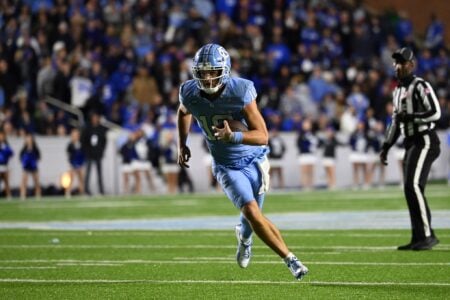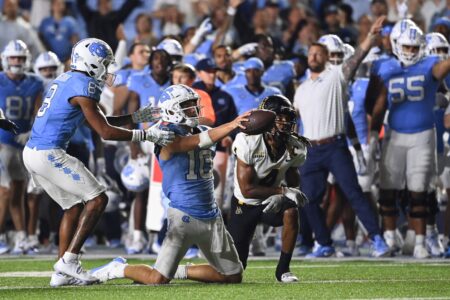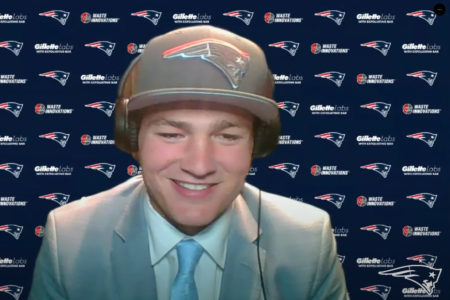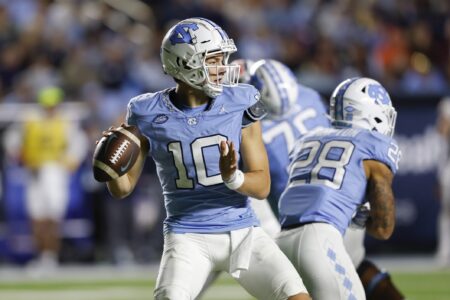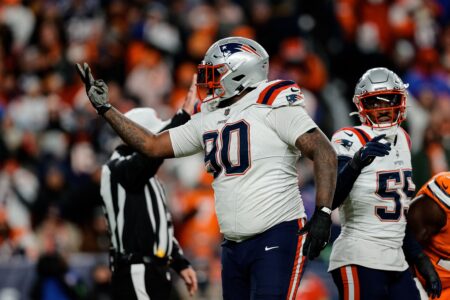to people who don't think the statheads have any idea what they are doing, or who don't understand the "nuances of the NFL". go read
this article. some excerpts from the guys at FO:
Diehl with the Fold
Early in the second quarter, the Giants started a drive at the Bears’ 32-yard line. Derrick Ward took a handoff, swept around left end, and gained 31 yards. It was a simple play from a two-tight end I-formation (Figure 1, the right wide receiver and two defenders aren’t shown), and there was only one wrinkle in the blocking scheme: Left tackle David Diehl and tight end Jeremy Shockey executed a fold block on the left side to help free Ward.
To understand why this play was so successful, let’s look at each blocker’s role, first in the design of the play, then in the way it was executed in Chicago.
Right Tight End: Blocks the defender covering him, prevents penetration. Kevin Boss does an adequate job stopping Adewale Ogunleye.
Figure 1: Derrick Ward Sweep
Right Tackle: Reach-blocks the 3-technique tackle and prevents him from pursuing down the line or occupying the right guard. Done and done.
Right Guard: Combo-blocks the 3-technique defender until the right tackle controls him, then pursues the backside linebacker on the second level. Chris Snee does his job well. He barely has to chip Darwin Walker (99) because right tackle Kareem McKenzie easily controls him. Because Lance Briggs (55) shoots a backside gap, Snee has no one to block and seeks out the safety.
Center: Reach-blocks the nose tackle. Another fine job by the Giants line.
Left guard: Combo-blocks with the center, then attacks the middle linebacker. Rich Seubert climbs to the second level, then catches a break when Brian Urlacher (54) briefly slips. Seubert walls off the slowed Urlacher.
Left tackle: Loops around the tight end, then either kicks out the force defender or logs the first defender to the inside. OK, now in English. Diehl is supposed to read the situation once he wraps around Shockey. The force defender is the defensive back aligned just outside the tight end when there is no wide receiver to one side of the field — Tod McBride in this case. Under normal circumstances, Diehl would smother him and try to push him to the sidelines. If McBride crashed into the backfield before Diehl arrived, Diehl would run to the hole, look inside, and block any linebacker trying to pursue. Something strange happened on this play: McBride froze and looked inside at the snap, even though all of the action was flowing outside. He probably had man coverage responsibilities on Shockey and got mixed up when the tight end released to block. The momentary confusion made him a sitting duck for Diehl.
Tight end: Fold-blocks and seals off the play-side defensive end. Shockey is a very good blocker, but he only does a so-so job on this play. Mark Anderson (97) gets inside him and penetrates. Shockey’s block takes Anderson far enough inside that the defender cannot redirect Ward.
Fullback: Lead blocks left. Takes on any defender who penetrates, or logs the first linebacker in pursuit, or kicks out any late arriving defenders to the outside, or races through the hole for a downfield block. Fullbacks have a lot of decisions to make, and Madison Hedge**** makes the right one here. With McBride caught inside, Bears linebacker Hunter Hillenmeyer alertly flows toward the sideline in an effort to force Ward back inside. That makes him Hedge****’s man, and Hedge**** makes a solid block.
Running back: Take the handoff and climb to the line quickly, aiming for a hole about a yard off the tight end’s left shoulder. Read the blocks of the fullback and left tackle to determine the cut. Ward executes properly and makes the right read, though the blocking is so good that he cannot go wrong. He executes a stiff arm at the safety level and high-wire’s the sideline for additional yardage.
Amazingly, Ward scored a two-yard touchdown three plays later on the exact same play. Same formation. Same fold block with Shockey and Diehl. Once again, Diehl and Hedge**** opened a big hole by cutting off the force defender and the pursuit linebacker. The only reason the plays didn’t look exactly alike on the highlight show was that Ward stopped running after two yards.
There are several reasons why this play worked so well for the Giants. One is so obvious that I won’t mention it until the next section; see if you can spot it now. Another is the defensive call by the Bears: Briggs and Urlacher were both crashing gaps at the snap, taking Briggs out of the play and making Urlacher an easy mark for a second level block. Throw in some execution lapses (Urlacher’s stumble, McBride’s hesitation) and you have the recipe for easy yardage.







